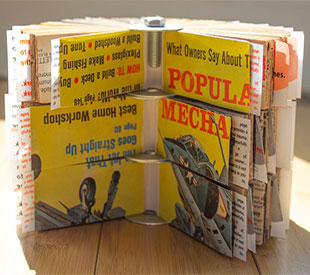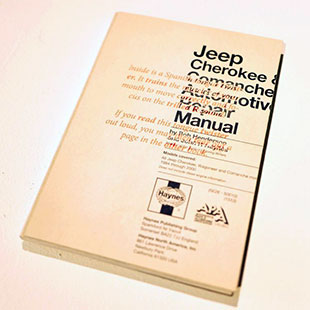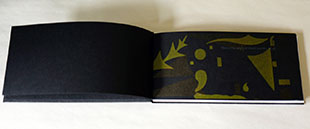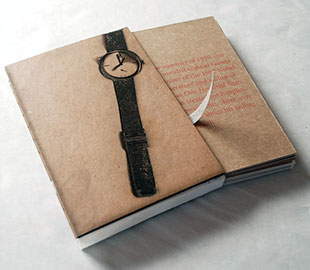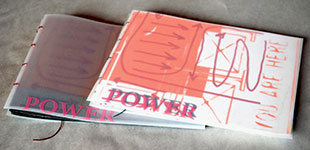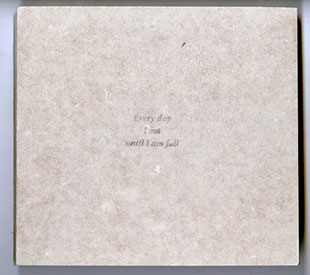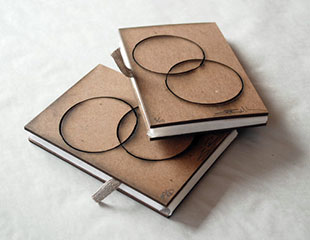
|
Savannah Bustillo~ Iowa |
Share this page: |
|
 |
Artist Bio: “Savannah Bustillo (she/her) is a queer, second generation, Colombian-American printmaker, bookmaker, and papermaker from Albuquerque, New Mexico. She combines making and anthropological investigation to explore spaces in the margins – where identities not easily reconciled are placed. She received a BFA from Washington University in St. Louis, with a concentration in printmaking and a second major in anthropology, and is completing her MA/MFA at the University of Iowa in printmaking. ” Artist Statement: “My work takes small discarded objects, sounds, and movements that seem silent and insignificant, and reemphasizes them to show both the strength and strain in marginality. It is within these histories and relationships between ‘authenticity’ and race that I want to trace where the relatable and everyday residues of these experiences leave their mark on all of us. For me this begins with language - a foothold into a realm of tastes, memories, and sounds. It is a visceral and poignant material that marks systems of power and force, but also a reminder of individual comfort, love, and care.” |
|
The History of Work 2 x 13 x 13". Materials: Sliced Popular Mechanics magazines (1960s-1970s), fender washers, screws, synthetic vellum. Screen printing. Signed and numbered by the artist. Savannah Bustillo: "This is a book about the history of work. About the history of LEVERs. WHEELs AND AXLEs. INCLINED PLANEs, WEDGEs, PULLEYs, and SCREWs. “These are the six simple machines. They are the simplest mechanisms that use mechanical advantage or leverage, to help minimize the force needed to do work. This book tells the story of the six simple machines: First defined in classical Greek texts on mathematics by philosophers like Archimedes, they were then further elaborated on by Renaissance darlings like Galileo and Leonardo da Vinci during the neoclassical revival in Western Europe. They are linear, unidirectional, ideal - without friction or elasticity getting in the way. While understood as limited in their applications in modern machine theory, their usefulness remains in their easy identification and casual everyday usage by people trying to do work. “This book is a compound machine. It is formed from the combination of simple machines contained in its pages, screen printed in layers of red and black ink on vellum, overlapping images of the simple machines with the words that tell their story. These vellum inserts fan out throughout the pages of the book like notches in a gear, turning their way slowly and methodically around the central axis of the book for viewers to read. The main body is constructed from a slice of a recycled American popular science and technology magazine called Popular Mechanics. Founded at the turn of the 20th century, this magazine was meant to engage the typical American man in DIY repairs, hacks, and gadgetry to properly maintain his home, car, and property while selling and showcasing tools and parts. “However, neither the six simple machines with their idealized leveraging of force, nor Daddy’s practical tips and good old common sense, are enough. There is more work to be done. What we know collectively of the history of work is assembled from simple components. Compromised and idealized. It ignores the friction from marginal bodies, their softer and quieter contributions. It ignores the buildup of stress and wear these excluded bodies face. I am intimately familiar with my own buildup of calluses, my own rubbed raw and then thickened skin - a necessity to protect a queer brown body like mine. “To aid this unacknowledged work and combat disproportionate strain, this book contains some hidden parts. There are four galvanized steel fender washers lightly taped onto pieces of the printed vellum inserts with instructions. Fender washers are designed to be load-bearing: to absorb shock and trauma from their environments. They are humble parts. Unassuming. Hidden under larger nuts and bolts. Viewers are given the following instructions: Peel off the washers. Hold them purposefully. Concentrate. Pass something you want to let go of to the washer, which can be left in a secret place. It will hold what you ask it to hold, as long as you need it. “This is a book about work. About failure. About the failure of work as we have previously acknowledged it and the need to make work work better. Work can be taught, passed down, practiced, and found. It exists as a link in a chain of simple machines that define work and by extension labor, power, and agency through specific operators and actors. “But there exist spaces and ways to appropriate these simple machines, these Popular Mechanics, these fender washers, the very concept of work. There are ways to make them our own. To work for us.” “History of Work” is the second in Bustillo’s History series. The first being “History of Language” |
||
The History of Language Two books 6.5 x 9.5". One cue card. Screen printed on a single recycled Ford Taurus & Mercury Sable car repair manual. Spanish screen printed text in one volume. English screen printed text in second volume. Bookboard covers with cloth spine. Signed by the artist. A two volume set in which the text is a Spanish tongue twister to teach the /rr/ sound. Savannah Bustillo: "This installation of books and cue cards is a game. It is an experiment, a grammar lesson. "Guests are invited by the cue cards and covers of the two books, placed side by side, to do a reading out loud. One book prompts the viewer with a set of directions in English, and the other in Spanish, with the promise that if a guest chooses to read the Spanish tongue-twister, or trabalenguas, out loud, they can then tear out and keep a page from the other book. This trabalenguas is one any Spanish-speaker will recognize – a classic that is recited to teach the speaker how to create the /rr/ or ‘trilled R’ in Spanish. It is a teaching guide; the more often one repeats the trabalenguas, the stronger the /rr/ will become as your tongue slowly adjusts to the correct placement in the mouth. "Yet, guests of course have a choice. If they choose to engage with the piece, their knowledge and comfortability with either English or Spanish will allow them to understand one of the two covers with instructions. When they then open that book, they will find the text block in the other language. The English covered book has the text block in Spanish and the Spanish covered book in English. Guests then will be confronted with the choice to try reading in the language in which they perhaps have less experience, trying to pronounce this trabalenguas, and then getting to remove a page from the other book. Over time, the choices audiences make will be displayed in what pages remain of the two books, themselves sisters. Both are created from a single recycled car repair manual, the English covered Spanish text block book comprised of the first half of the manual, and the Spanish covered English text block book comprised of the second half. Not only is this installation an experiment, but a reminder, via car manual, that the history of language cannot be divorced from the physical material of the world, nor the mechanical ways we try to train our mouths to accommodate different linguistic paradigms. "This piece is a microcosm—a small study in how languages, words, pronunciations, and practice are shaped and continue to be shaped by living people engaging with them. It is a demonstration of the way language lives and breathes between us all. It is also forged around the innate performativity of language, the privileges that surround us and grant some of us accessibility to certain ways of speaking and understanding, and also a longitudinal study of the way the repeated use or disuse of languages shapes our histories." “The History of Language” was a 2022 MCBA finalist. |
||
This is the story of Peter and the Wolf and Alex 3.5 x 7.5 x .5 inches; 44 pages, 7 vellum inserts. Letterpress and screenprinting. Dingbats printed in various colors. Black pastedowns and free end pages. Bound in black handmade/hand-dyed cotton paper over boards. Signed by the artist on the back pastedown. Sources: Recordings from Stanley Kubrick's 'A Clockwork Orange"; text from Peter and the Wolf. Savannah Bustillo: "This is the story of Peter and the Wolf. As viewers turn through the pages, this classic children’s tale is recounted amongst an abstract scenery of letterpressed dingbats. However, every few pages the viewer will find a vellum insert with a sound wave and a caption, all taken from Stanley Kubrick’s film, 'A Clockwork Orange'. Ranging from the sounds of the main character, Alex, enjoying a car chase with his friends, to him violently assaulting a couple in their home, to the final ending credits song of Gene Kelly’s 'Singing in the Rain', these cuts of sound infiltrate the Childhood narrative. Yet, as the viewer continues reading, the dystopian fascist society Kubrick creates has much more in common with Peter than we might originally imagine. Both Peter, as the innocent boy archetype filled with enthusiasm and gusto to hunt the Wolf, and Alex, a violent lusty nihilistic teen act upon others to their fancy, without care of concern for anything beyond their own desire. The tragedy that befalls the other characters like the Wolf or nameless women are unremarkable occurrences, used to further display the cunning or will of Alex/Peter. Boys will be boys." |
||
The Calvin Klein watch Omi gave me 6.25 x 4.25”; 72 pages including covers. 9 vellum inserts making 36 of the pages. Laser engraved images. Screen printing. Coptic stitch binding Constructed of pages of untreated chipboard and vellum. Housed in an open sided box of untreated book board with laser engraved images of a Calvin Klein watch on front and back. Signed by artist on back of box. Savannah Bustillo: "The book recounts the true story of the famous Colombian novelist and poet, Gabriel Garcia Marquez, who was treated for lymphatic cancer in 1999. Viewers turn through laser engraved images of Colombian souvenirs and tchotchkes and pages of screen printed vellum with the same ghostly watch from the box. The text continues that various news sources took the rumors of Garcia Marquez’s failing health to be confirmed when a poem was leaked to a Peruvian newspaper that the poet had sent this only to his closest friends. “The world press was taken by this poem, which emphasized how the beloved poet was not ready to die - seemingly the unreserved words of a scared and dying man. However, it was confirmed later that Garcia Marquez had not written the poem. It was instead written by a Mexican ventriloquist for one of his puppets. The book ends with the full poem reproduced. “How do we make sense of and attach meaning to occurrences, poems, or objects, even when we know them to be inauthentic or illusionistic? The Colombian objects were things sent to me throughout my life by my own Austrian - Colombian grandmother or Omi as I called her. The Calvin Klein watch was the last object Omi ever sent me before passing away in 2018.” |
||
I took a walk through the city: I was alone. 5 x 6.5"; 16 pages. Screen printing. Coptic stitch binding. with vellum covers. Edition of 25 printed on white papers. Edition of 9 printed on gray papers. Signed by the artist. Savannah Bustillo: "Created with bright screen printed colors with a mix of text, drawn arrows and lines, and collaged images/text from sections of post-structuralist philosopher Michel Foucault’s ‘Discipline and Punish’. This book features an imagined diagrammed cityscape and the musings of someone who wishes she could explore this space freely. The text is a meditative stroll through this imagined space, considering the connections between inhabiting space and feelings of power." |
||
| Savannah Bustillo SOLD / Out of Print Titles: | ||
15 Things I learned from my Grandma 6 x 4 x 4 "; 24 page including exteriors. Materials: mylar, thread. Pronto plate printing. Pamphlet style sewn binding. Savannah Bustillo: "Created in the spirit of play and to embrace the book as a three-dimensional object, this book features lithographically printed Colombian souvenirs from my childhood and other notorious Colombian products, overlapping and collaged in rich translucent color. These souvenirs were sent to me throughout my childhood from my grandmother living in Bogota, Colombia, arriving in suitcases that my father would bring home after trips abroad seeing his mother. The wide variety of objects featured here - woven jewelry, magnets, sweets like arequipe and bocadillo wrapped in dried banana leaves - combine personal and nostalgic forms with commercial products that Colombia is known for - emerald jewelry, masks and ceramic goods, mined stones, textiles, and coffee. These books offer a collection of objects that I return to again and again, to reflect broadly on the multifaceted points of the things we collect: personal mementos, circulating resources, exotic forms, and pieces of knowledge or wisdom." |
||
Every day I eat until I am full 7 x 7.25 x .75"; 33 Pronto plate prints (2 bound in book..31 prints laid in). Bound in paper covered bookboard with cloth spine. Title on front cover. Signed by artist on back cover corner. Artist Inspiration: "One bag of tortillas, my skin color, my brother’s skin color, pronto plate" Savannah Bustillo: "Centering a phrase I am told over and over again, “I thought you were just another white girl.”, this book spans an entire bag of corn tortillas - a staple food I’ve eaten since childhood. The first tortilla is printed in an ink matched to the color of my own light skin tone. With each subsequent page, the ink is methodically darkened, up until the final page which matches the color of my brother’s skin tone. The content of the book can be pulled out as a set of cards, a type of aggregate data that can be poured over and compared. How can our own understandings of whiteness/brownness be challenged across a visual spectrum? Where is the tipping point of what we recognize as other? “This book asks the viewer to grapple with these larger systems of how identity is assigned, while also placing the viewer as reader/receiver of this phrase, ‘I thought you were just another white girl.’ Again and again this phrase must be ingested/digested by the viewer on a new tortilla. To what degree can the viewer control this pacing? It is my goal here to not create a project just around the systemic, but also around the weight of what the individual must bear - to be told by others again and again that you do not look how you are supposed to, and to bear the burden of proof and explanation of why you look a certain way. While at first giving this explanation might feel neutral, insignificant, or even a chance at an interesting conversation, at what point will the reader face saturation or unbearable overfilling?” |
||
Hoops and SPF 50 4.75 x 3 x .5” open sided box of book board containing two zines with cotton ribbon pull. Box constructed from untreated book board. One board laser engraved with an image of a sunscreen bottle. Other board laser engraved with image of hoop earrings. Zines text and images blind embossed on white bleached cotton rag paper. Each zine one sheet book construction forming 8 panels each. Signed and numbered on the back board of the box. Savannah Bustillo: "The zine featuring more images of the sunscreen bottle begins with the phrase: ‘I feel least colored when I wear SPF 50.’ Each subsequent page redacts more and more words from the phrase but presents different scenarios for when I have similarly felt least colored. The other zine follows a similar pattern, instead featuring images of the hoop earrings and the phrase ‘I feel most colored when I wear big hoops.’ “Meant to continue the legacy, from the American artist Glen Ligon’s iconic piece ‘I feel most colored against the sharp white background of the gallery wall’ and then all the way back to Zora Neale Hurston’s essay ‘How It Feels to Be Colored Me.’ These zines are meant to sit in the liminal spaces where I feel most and least colored.” |
||
Page last update: 07.23.2024
Home | About Us | Contact Us | New Arrivals | Fine Press & Artists' Books | Broadsides |Resource Books | Order/Inquiry
Copyright © 2023 Vamp & Tramp, Booksellers, LLC. All rights reserved.
